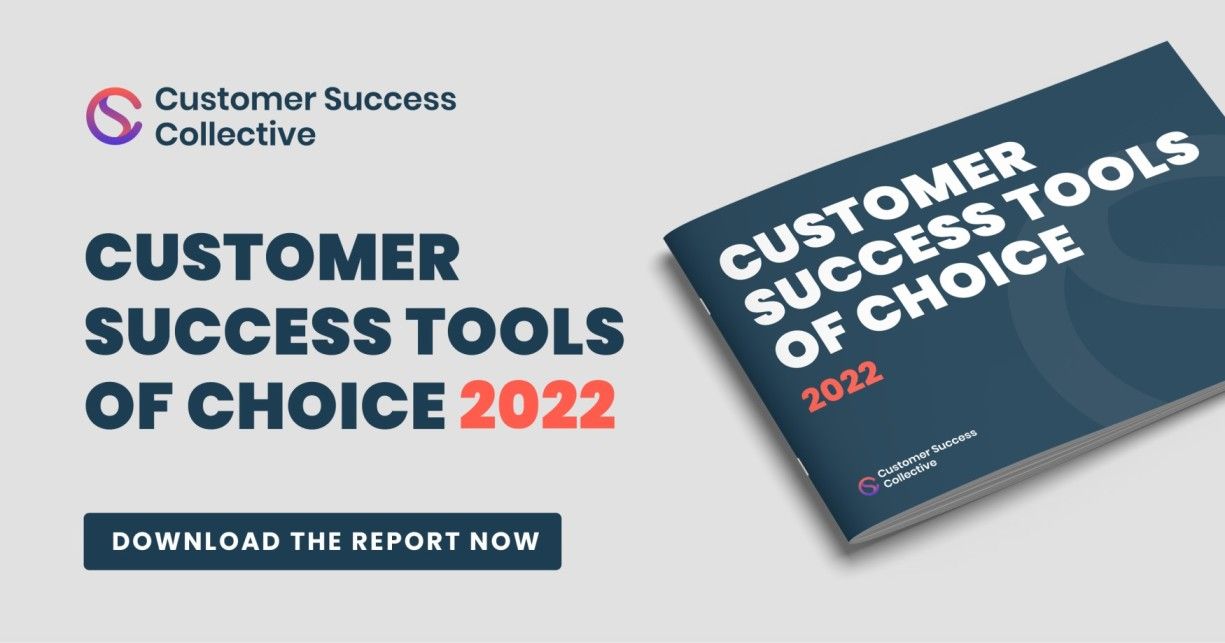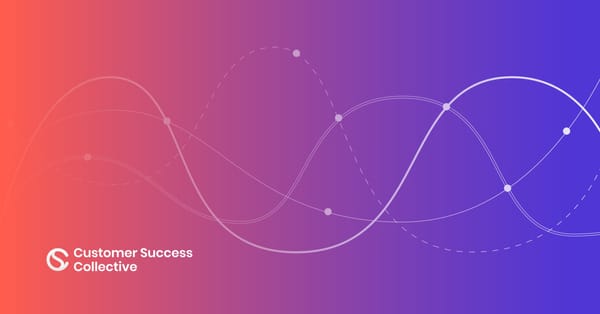The metrics used to measure customer success are the cogs that propel the CS machine; without them, you’re looking at an uphill struggle detecting exactly how your customers are doing.
If you speak to any CSM or even do a quick Google search to ascertain “what is customer success?”, without a doubt, your answers will describe customer success as a function that drives product value and adoption through the tools of empathy and communication.
In fact, in our seminal report, The State of Customer Success 2021, humane characteristics like communication (88%) and listening (71%) were voted as prerequisites to a prosperous career in CS.
All this is completely true, we’re not denying it. But like anything worth your time, it’s a little more complicated than this straightforward explanation; there are two sides to this customer success coin.
In this guide, we're going to focus on the following key points:
- Measuring customer success
- What is customer success?
- Repeat purchases
- Customer lifetime value
- Customer retention
- Customer satisfaction score
- Churn rate
- NPS
- Customer effort score
- Customer health score
- MRR and ARR
- Qualitative feedback
- Customer success software
Not got time to read the full article right now? No problem! Take it away with you as a handy eBook. 👇

What is customer success?
In a nutshell, customer success is all about making sure your customers get the most from you to help them achieve their ultimate goals. At face value, it sounds like an obvious and simple strategy — something that all businesses are surely doing, right?
Before we continue, for anyone wondering what the difference between customer service and customer success is – let’s quickly clear that up.
In short, customer service is a reactive relationship between customer and company; if there is a problem with a product or service, the customer service department will listen to the customer, resolve their problem, then draw a line under it. Finito.
Customer success, on the other hand, wants to actively find out what is and isn’t working for the customer before the complaint stage. This ultimately makes it a proactive relationship, one that actively continues after the point of sale and evolves with time.
Developing the right products is important, but the products themselves can only take you so far; you need to improve your whole sales process and after-sales initiatives. You also need to explain the benefits of your products and services to them in a manner they'll understand so they're more likely to get exactly what they want, rather than just giving them what they think they want.
Customer success isn't just about selling your products to someone and forgetting about them, it's about building a long-term relationship that’s mutually beneficial for you and your customers. And much like any successful long-term relationship, the key is communication. Listening to your customer and understanding what they require from your product is crucial.
Proactivity and reaching out to customers can go a long way, and having a comprehensive customer success approach will help build customer loyalty and improve customer retention in the long run. This can also help you grow your business by using existing customers as marketing outreach.
With the right approach, you'll be able to build a business that:
- Speaks to your customers' specific needs
- Educates them on things that might be even better for them
- Sells offers effectively
- Helps customers use your products and services comprehensively
- Remains with them after a sale to assist them with anything else they might need
It works for both you and them on a number of levels, but it also needs to be measured effectively.
Businesses that have built the right customer success strategy can see huge long-term gains in customer retention, increased sales, and profitability. If your business is in its customer success infancy, it’s wholly worthwhile to understand the basics of customer success. With full possession of the facts, you can ensure healthy feedback and, ultimately, the growth of your business.
Measuring customer success
Creating the perfect journey for your customers is critical and many businesses fail to realize this journey extends beyond the point of sale.
Believe it or not, forgetting to implement an effective customer success strategy can actually be tantamount to self-sabotage! Treating it as a priority could help you reach the next level while your competitors get left behind.
Customer success is a huge topic, and one that's still relatively new for the industry – but don’t let that fool you into thinking it’s any less important. Like most things in life, the best way to initially get your head around customer success is to take a more in-depth look at it.
And by doing this, you can discover how to actually measure it, eventually evolving this data into a solid strategy. There are a huge number of new metrics you can use to determine whether your customers are getting everything they need from your business – so that they can achieve their goals with your product, or service.
Finding out how these metrics operate can detect the welfare of your business and ensure its health before things turn unsavory. Some of these metrics can be complicated, but having a complete understanding of how they work and how to put them to use can be an absolute game-changer for the future of your business.

The importance of measuring customer success
Staying on top of your customer base is super important, as it allows you to understand how your customers are engaging with your product and gives you the opportunity to identify any at-risk customers with the potential to churn.
The whole point of customer success is to create healthy, lasting relationships with your customers post-conversion, so keeping one eye on their well-being is an indispensable part of the job of any CS practitioner. How to do that? With specific metrics, of course.
With metrics, you can measure their overall satisfaction, product activity, and usage, to give you a better idea of where you can improve.
But it’s important to remember that customer success isn’t static. It’s an ever-changing business function positioned at the end of the sales process that is dependent on all areas of business can be hard to pinpoint exact metrics
Because the aim of a customer success strategy is more organic and seeps into many other unrelated areas of your business, it can be hard to calculate an exact ROI based on your efforts. It's easy to measure the cost and ROI on something like customer support, which tends to just begin and end with a problem being solved. Customer success tries to circumvent the ‘problem’ aspect entirely.
When you build a sales funnel, it's easy to measure metrics like click-through rates and sales. The data is normally right there in front of you. But when you've been building an approach that’s dependent on indirect strategies you implemented months before to improve your bottom line, it can be harder to know what worked and what didn't.
Metrics to measure customer success
Customer success is made up of a delicate balance between tech touch and human interaction. In fact, it’s one of our key principles in The Customer Success Manifesto.
Unlike established business functions like sales and marketing, customer success is the new kid on the scene with a myriad of interpretations as it evolves at a rapid pace. In order for customer success to be considered a viable business function, it simply cannot exist without metrics and data.
Customer success should be scientifically-based, as well as rooted in empathy. There are a number of key metrics you can use to help improve your customer success strategy as well as knowing whether your methods are getting results yet or not. Let's have a look at them in a bit more detail with some different metrics to use when developing and evaluating your customer success strategy:
Repeat purchases
Knowing your repeat purchase data is hugely important in determining customer success, so you either know you're on the right path or can make changes to your offerings. After all, if they’re continuing to buy your product, this strongly suggests they’re happy with the level of service you’re providing!
When someone's service contract has expired, do they renew? When they need another similar product, do they buy it from you? This data is crucial, which is why we'd like to introduce repeat purchase rate (RPR). The better your RPR, the more success your customers are having with your products or services. But how do you calculate your RPR? Good question.
Before you get cracking, you're going to need two figures to hand:
- The total number of customers over the period you're measuring
- The total number of these customers that made a repeat purchase in that timescale
Purchases can be manifested in a couple of different things, either in products or renewing a service contract. The time period you choose is completely up to you; while one year is standard, you can look at smaller or even larger time frames if you want to. The world’s your oyster!
To calculate RPR, you divide the number of customers who made a repeat purchase by the total number of customers you've had. For example, if you had 1,000 customers and 500 made repeat purchases, then your RPR would be 0.5 and 50% of your customers would’ve made repeat purchases. This is just a simple example, and an RPR of 50% would be incredible, albeit insanely high!
But for the million-dollar question: what actually makes a good RPR? This depends on your industry and type of product, so annoyingly there isn't one fixed answer. But obviously, more is better. And RPR really comes into its own when compared with rates in previous years, before you started taking customer success seriously. So go back and calculate your RPR for the last 5 years. It should hopefully be increasing, especially if you start implementing customer success strategies effectively.
What is customer lifetime value (CLV)?
It’s no good basing your success after the initial sales conversion and forgetting the post-sales health of the customer. Measuring customer lifetime value can be crucial in determining how successful your customers are and how much you can expect to earn from them
Customer lifetime value (CLV) is another important metric: it tells you how much a customer is worth to you for the entire time they spend with your business.
Many businesses make the mistake of only calculating how much they get from a customer from an initial sale, ignoring the value of a customer further down the line. Let’s not be selfish guys! If you're providing success for your customers, they should (hopefully) continue to do business with you for a longer period, buying more products and services – especially if your RPR is high.
So CLV can be crucial in determining how successful your customers are and how much you can expect to earn from them – either annually, or over a longer timeframe. Knowing this data isn't just important in making sure your customer success strategy is on point, but can also help in forecasting and financial planning (especially if you're trying to raise capital from external sources for a new venture).
CLV can give you two important pieces of information:
- The average length of a relationship with a customer
- How much you can expect to earn from them per year (annual revenue)
To calculate the CLV, find out:
- What the annual revenue is from a customer
- How long you've been doing business with them
- How much it cost to acquire them
Once you’ve figured that out, you can:
- Multiply the annual revenue per customer by the relationship length
- Then subtract the cost of acquiring them
This will tell you your customer lifetime value. One important thing to remember is that the CLV for a customer can be fluid, as if you calculate it today, it might not have been the end of the relationship with that customer. Their value will have changed in a year's time if you are still doing business with them, so make sure to calculate it regularly.
For Aymain Hussein, Director of Customer Success, Data AI & Advanced Analytics at Microsoft, customer lifetime value is defined as follows:
“CLV is a metric or an index that quantifies the amount of money an existing or perhaps a new customer is expected to spend while doing business with me over a duration of time.”

Generally speaking, a happy customer will go on to purchase more frequently, and the purchases will (hopefully) be on a larger scale.
Looking for actionable ways to increase your CLV?
- Concentrate on implementing a water-tight onboarding process
- Offer customer loyalty rewards
- Monitor customer activity
- Close the feedback loop

What is customer retention rate?
Customer retention rate is a similar metric to repeat purchase rate, but is more applicable to businesses selling ongoing services, rather than one-off products.
Calculating retention rate gives you similar useful information based on retaining service contracts rather than selling products repeatedly, although both can be used effectively no matter what your business model is. Say if a business starts the year with 100 customers, but loses 25 along the way, it has a 75% retention rate. Of course, this doesn’t take into account new clients, which will in turn affect the overall retention rate.
In fact, the value of retention rate is so significant that it embodies the basic, singular truth in customer success: it is far cheaper to keep existing customers than to seek new ones. By increasing retention by merely 5%, you can expect to see profits rise from 25% to 95%. What’s not to like about those figures?
Other key metrics to look at:
While these are some of the most important customer success metrics, they aren't the only ones. While they can be a good introduction to the start of your customer success journey, you might want to dive a bit deeper when you've started implementing them successfully.
Customer satisfaction score
Giving the customer the opportunity to rate your brand’s product and service seems like a fairly self-explanatory measure. Something was good, or it was bad. While the essence of this customer success metric is entirely true, marketers can utilize customer satisfaction scores to their advantage by implementing depth and layers to the customer’s critique.
You can gauge whether a customer was satisfied by supplying them with choices like these:
- Very satisfied
- Satisfied
- Neutral
- Unsatisfied
- Very unsatisfied
This all seems pretty commonplace, right? Well, one of the reasons customer success doesn’t always have the most reliable data is due to casting wide metrics. For example, unless the customer satisfaction score was broken down further, if you get a good or bad rating, you aren’t immediately aware of what stage in the buying process this occurred.
So the intricacy of this data needs to be filtered even further. You can apply your customer satisfaction score to different stages in the purchasing process, identifying the strengths and weaknesses of your service and product to your business’s benefit.
All of these metrics can help you evaluate how successful your customers have been, and they will equip you with a strategy to make them more successful with your product or service.
Churn rate
And no, before your brain even remotely wanders, we’re not on about the logistics of making butter! As delicious as that sounds, we’re actually talking about something wholly sinister and fear-inducing: losing customers (*plays dramatic sound effect*).
Yep, you heard it here first. A high churn rate is a business’ nemesis and the antithesis to customer retention. A churn rate definition would essentially describe the number of people who stopped buying your product or subscribing to your service within any given period of time.
Calculating customer churn rate is a top priority for any customer success specialist, or customer success manager (CSM). It’s an important metric to have under your belt, albeit not a particularly nice one if you discover you have a high churn rate. But by learning the mechanics of churn, you will be taking your first steps towards customer retention.
There are two different types of churn: involuntary and voluntary. A customer who involuntarily churned would be someone who stopped subscribing because they forgot to update their new credit card details and the payment bounced.
Voluntary churn is somewhat different. This is when a client chooses to leave your business for a reason stemming from dissatisfaction with the product, price, or service.
To work out your churn rate, the formula is pretty simple:
Number of customers lost in a period / Number of customers at the beginning of the period
But people churn for different reasons, so it’s a good idea to segment your groups by related reasons for churn. This way, when looking to reactivate churned users, you’ll gauge a more accurate reflection of what needs to be done for each customer.
For example, someone who left due to involuntary churn will need a different approach to someone who left because of a new feature update, or perhaps because the price was too high. Determining why people churn, through customer segmentation, is a pivotal point when creating your churn strategy.
Did you know?
- Avoidable churn costs US businesses a whopping $136 billion a year
- Two-thirds of consumers leave companies because of poor customer service
- Customer churn can drop by 67% if you resolve issues in the first interaction
- Only 1 in 26 people actually complain when they’re unhappy, the other unhappy customers silently churn.
- 58% of consumers said they’d never return to a company if they have a negative reaction
- Around 12% of credit cards will fail
- 85% of customers don’t respond to those ‘remember to update your card details’ emails
Customer retention cost
As we mentioned before, it’s actually cheaper for businesses to consolidate their efforts by retaining existing customers rather than to seek out new ones. This is because, with existing customers, all of the onboarding and early-stage tactics have been done. And because of this, they’re more likely to make repeat purchases or even spread the word to others.
To do a breakdown of customer retention cost (CRC), you would find the following as its core factors:
- Your customer success team
- Your renewals or account management team
- Any customer engagement monitoring systems and/or productivity tools
- Any customer engagement and adoption programs
- Any professional services and training required
- Customer marketing
In short, to work out your annual CRC you will need to factor these expenditures into account over the last quarter multiplied by four. From this, you can work out how much it costs to retain individual customers. Simply divide your annual CRC by the total number of active customers.
Net promoter score
Your net promoter score (NPS) is literally a simple case of good minus bad.
When presented with a scale, ordinarily between 1-10, customers can choose a score that represents their likelihood of recommending your product or service to others. You can break down the scores into categories of promoters (9-10), passives (6-8), and detractors (0-5).
Just ask your customers the following:
'On a scale from 0 to 10, how likely are you to recommend this product/company to a friend or colleague?'
- For those who vote 9-10, they’re your promotors. They’re the good eggs!
- Those who score between 6-8? They’re more of a passive customer who isn’t likely to recommend your brand.
- The dreaded detractors are categorized with a score of 0-5 – you want to change this number ASAP.
To work out your net promoter score, you simply subtract the number of detractors from your promoters. You might be wondering about factoring the passives into all of this. Well, that’s a good question, but ultimately if people feel that apathetically about your product or service, chances are they won’t bother spreading the word, whether it’s good or bad.
In our report, the State of Customer Success 2021, we asked over 200 participants what KPIs they were measured on. After retention rate and churn rate, NPS was listed as one of their main KPIs, coming in at 41.2%.
While it’s not a concrete metric, NPS is an important one when looked at in conjunction with other key metrics like churn rate, customer satisfaction score, and ARR.
Customer effort score
Now a customer effort score (CES) is a similar metric to the previously mentioned customer satisfaction score, except it’s trying to gauge how easy the customer found engaging with your company.
The customer will be presented with a series of options, detailing a myriad of options that will (hopefully) reflect their experience. Typically, they will be presented on a scale of “very difficult” to “very easy”.
According to The Effortless Experience (2013), 96% of customers become disengaged and ultimately disloyal to a product or service that demands a high amount of effort from them. I mean, can you really blame them? If your product or service is cumbersome and inefficient, it can test even the most patient of customers.
Like all customer success metrics, the CES shouldn’t be treated in isolation. It’s at its best when used in conjunction with Net Promoter Score (NPS) and is ultimately a good indicator of customer loyalty.
Customer health score
To boil it down, your customer health score is another key performance indicator (KPI) that allows you to measure how likely your customer is at risk of leaving your business.
Customer success managers will use this metric to monitor the state of their customers and assess the probability of contributing to churn. Essentially, it determines whether the customer is ‘healthy’ or ‘at risk’ which makes it a good metric to calculate before the fate of the customer is too late.
No company will measure its customer health score in the same way. But that’s okay. It’s simply a way to combine and analyze all key aspects of customer engagement. For example, your customer health score will:
- Examine how frequently your customer is using your product or service
- Reflect the depth of which your product or service is being used
- How many people (the breadth) are using your product or service
Monthly/annual recurring revenue
Your monthly or annual recurring revenue (MRR/ARR) is a predicted value of what your business will financially make over the course of a month or a year.
Let’s say your service had 500 subscribers and you were charging them $20 per month, your monthly recurring revenue (MRR) will be $10,000.
Of course, your MRR or ARR figures aren’t set in stone, so they will need to be taken with a pinch of salt. If calculated correctly they can be incredibly valuable predetermined projections. Sounds pretty fair?
However, if you wildly overestimate your MRR or ARR, and significantly underachieve on your predicted targets, this could massively impact the trajectory of your business. In turn, this could even negatively affect your relationship with any investors and their view on the health or even the legitimacy of your business. Our top tip? Maybe try not to miscalculate your MRR or ARRs!
Qualitative customer feedback
Customer success (collective) is our name, and analyzing quality feedback is most definitely our game. As it says in the name, your qualitative customer feedback is a little bit different than quantitative feedback.
Quantitative customer feedback is rather black and white: it’s numerical data that can be collated and presented objectively. On the other hand, qualitative customer feedback is data that is interpreted subjectively, collating customers’ answers to open-ended survey questions, direct contact, or via reviews on social media. It’s a type of feedback that needs a different approach; the customer provides a verbal response and therefore a customer success manager will have to understand the motivation behind the customer’s feedback.
Qualitative customer feedback really is an exercise in interpreting human emotion; genuinely listening to what the customer feels, not just analyzing their activity and considering them as numbers.
Building a perfect customer success strategy
Once you've collected and calculated the data, you need to start implementing it by improving your customer success strategies. There's a lot of information to start looking at, and it can be a bit overwhelming if it's something new to you – but it shouldn't be neglected. Remember, you're already getting ahead of some of your competition by even knowing this information, let alone implementing it effectively!
You might want to consider hiring a customer success consultant, or an expert in the field to help you both calculate and implement all this data. Even for just a short period of time, it could pay for itself and more in the long run. The more customers you start retaining, the more you can earn from the duration of your relationship with them.
You'll then be able to develop new products or adapt existing ones with these success metrics in mind. And that's not the only silver lining; in the process, you'll be improving your entire sales process through improved communication. It's a clear-cut win-win. If you aren't retaining your customers for long enough, you might want to have a look at why and improve your products and services to keep people loyal for longer.
One key indication that your sales pitch is good, but your actual products and services aren't matching up to expectations is a low repeat purchase or customer success ratio. If people are buying your products but never making another purchase, there's probably a reason why. Maybe you sold them something with a great promo but that didn't actually help them in the way it said it would. Maybe your customer service and support aren't up to the job.
When you have all this information at your fingertips, you'll be able to better implement strategies to retain customers, keep them loyal, and increase their lifetime with your business. You'll also be able to evaluate these metrics over time to make sure they're always improving and heading in the right direction after you've started adapting your strategies or improving your offers.
Customer success software
If you’re wondering how to calculate your CS metrics, then you needn’t fret – gone are the days of using an abacus and chalkboards! Software dedicated to customer success exists to help your clients achieve their goals.
There’s a wealth of software on the market that is phenomenal; a plethora of different tools for different aspects of CS. From software helping you segment your customers, to programs dedicated to navigating the onboarding process, having the right tools behind you will make the world of difference.

If you’re building your CS team from the ground up, you might have a limited budget compared to more mature teams. Figuring out what software to invest in doesn’t have to be an overwhelming task.
According to Dan Farley, VP of Customer Success at Distributed, you’ll most likely have many different types of customer data points in your company, which will require different approaches. Dan identifies these data points as your CRM, user action data, email tools, and your customer support tool.
Each data point will ultimately feed into your CRM system, making it the single source of truth for customer data, adding that this is pretty much what a tool like Gainsight will do. For Dan, a “CRM can be the driving force behind all of this. This is basically what you will be using to emulate your customer success tool, you will run reporting in here, all of your operations will run in here.”

Let's wrap up...
As you can see, if you're new to customer success then you might have to learn a few new ways of collecting and measuring data. But there are tons of benefits to developing the best customer success strategy for your business, and real ways to analyze your results. Customer success is the next big thing in the SaaS business world, and it isn't something you should neglect.
Once you start seeing the data and having an idea of what works and what doesn't for your business, you'll be able to adapt your customer success strategy more efficiently. Knowing where to improve your processes and what you're already good at can be extremely helpful. If you aren't retaining customers for long enough, you'll be able to adapt your strategy to help you even more.
Don't rely on internal assumptions when it comes to customer success; it’s important to back it up with data. Then you'll know where to direct your budget and what parts of your business you're already good at.
Measure your way to success
Mastering customer success metrics is critical for any Customer Success Manager. With customer success heavily dependent on analyzing customer data, knowing how to best implement metrics is very much a quintessential skill for a CSM.
This is where we come in.
CS Metrics: Certified is your golden ticket to a treasure trove of insights that'll help you present your findings to key internal stakeholders to promote the benefits of customer success.
🌟 5 modules
📝 40 exam questions
🔖 6 templates
📚 3+ hours of content
🎖 Official certification
⏰ 100% self-paced.
With intel from CS leaders plying their trade at companies such as LinkedIn, Seek, and Chili Piper, you'll be implementing CS metrics in your day-to-day work in no time.



 Follow us on LinkedIn
Follow us on LinkedIn




